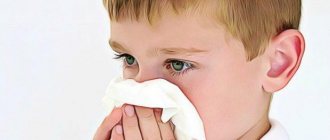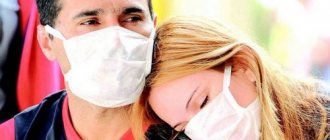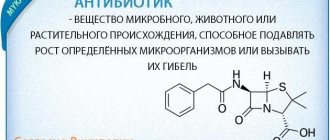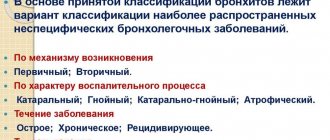Should I worry?
Residual cough is considered normal. But if it persists for more than two weeks, then this may indicate the presence of serious complications, for example, chronic bronchitis or pneumonia. In this case, it is better to consult a doctor, who, using a diagnostic examination, can determine whether a lingering symptom is part of some serious illness.
Why does a cough occur after the flu? Despite the fact that the acute period of the disease lasts only a few days, during this short time viruses and bacteria manage to damage the mucous membrane of the respiratory system. The sensitivity of the bronchi increases and because of this, a variety of factors can provoke a coughing attack: cold and polluted air, temperature changes. During this period, a dry cough usually occurs, and if sputum is separated, it is very scanty.
Recognizing and diagnosing influenza
Since influenza is a viral infection, it takes up to a week for the pathogen to cause symptoms from the moment it enters the body.
The typical clinical picture is represented by the following manifestations:
- A sharp rise in temperature above 38 °C.
- Intoxication manifestations: chills, weakness, aches and muscle pain.
- Respiratory symptoms: dry mucous membranes of the nose and mouth, soreness, tickling in the throat, pain and discomfort in the upper chest, cough without sputum and increased respiratory movements.
The influenza is also favored by its seasonality, since an increased incidence is observed in the winter. The cough is usually dry and hacking, debilitating the patient. If sputum or other changes appear, this may indicate complications, which are presented below:
- Bacterial tracheitis or bronchitis, which develops due to a weakened immune system due to influenza.
- Laryngitis with the formation of false croup occurs with a pronounced barking cough, turning into stenosis of the larynx with attacks of suffocation.
- Viral pneumonia will be characterized by coughing up sputum, shortness of breath, and respiratory failure.
- Pulmonary edema is detected by the presence of blood in the mucus and worsening shortness of breath.
A mild course of infection is characterized by a decrease in temperature on days 3-5 of illness, but cough and other respiratory symptoms may persist for some time. If the temperature lasts longer and the patient’s condition worsens, then you need to consult a doctor.
Important! The flu never begins with a runny nose or wet cough; these symptoms indicate the development of viral or bacterial complications and are connected during the development of infection.
Fighting methods
A doctor should treat a cough after the flu. The basic treatment principles include the following:
- diagnosis of the underlying disease;
- choosing the right tactics for the treatment process;
- softening the mucous membrane of the respiratory tract;
- elimination of irritating factors;
- relief;
- creating conditions that have a beneficial effect on the hydration of the mucous membrane;
- taking local medications that have anti-inflammatory, antiseptic and enveloping effects.
Doctors often prescribe Sinekod or Erespal; let’s take a closer look at these medications.
The main active ingredient of the drug is butamirate. The drug acts directly on the cough reflex. Sinekod is available in the form of syrup, tablets and drops. The tablets are taken twice a day - morning and evening. The drug is taken in combination with other medications and vitamin-mineral complexes.
The drug is available in two dosage forms: syrup and tablets. This is an effective medicine with an anti-inflammatory effect. Erespal is used for both dry and wet coughs; the effect of this drug is manifested in improving sputum discharge.
Don’t forget about the simplest and well-known measures: dress warmer, drink more fluids, apply mustard plasters, etc.
You can learn about the treatment of cough due to influenza here.
Drugs for treatment
What should you take for a cough with the flu? How to treat this symptom, which brings so much trouble, often preventing normal breathing and sleep.
In the case of dry cough syndrome, the use of antitussive drugs will help.
When it comes to treating a wet cough, agents are recommended that can thin the mucus (they are also called mucolytics) and help it come out faster (expectorants).
Medicine for this reflex can be represented by the following types:
- Drugs that have a bronchodilator effect. Thanks to them, the muscles of the bronchi relax, spasms are relieved, and a cough attack is eliminated.
- Mucolytics. They help restore the bronchial mucosa and make the lungs more elastic. Thanks to them, the viscous secretion liquefies, although the secretion of sputum does not increase. It is especially worth paying attention to the benefits of Ambroxol, Bromhexine and ACC.
- Opioid drugs that depress the cough reflex - they increase the threshold of irritability in the brain, as a result of which the cough is blocked. At the same time, some of these drugs (for example, Codeine) also depress the central nervous system and cause addiction.
- Non-opioid drugs that have a central effect - unlike opioid drugs, they are not addictive.
- Oral expectorants - thin mucus and help the patient cough up. For example, Guaifenesin is considered an effective medicine (although it is worth considering that it has side effects, such as nausea and vomiting). It is important to follow the correct dosage of the medication.
- Combined medications are drugs that affect the patient’s body in several directions simultaneously.
Inhalations as a treatment
I would like to immediately mention the advantages of inhalations over other treatment methods. For example, unlike syrups and tablets, inhalations act directly on the mucous membrane and muscles of the respiratory system.
Typically, the following medications are used for inhalation:
- mucolytic agents that dilute sputum well and promote its rapid elimination;
- bronchodilator medications;
- antibacterial agents;
- antiseptics;
- herbal medicines;
- mineral water or saline solution to moisturize the mucous membrane.
Let's talk about common inhalations that will help cure a severe cough.
Alkaline inhalations
This type of inhalation is one of the most common and accessible. The duration of the procedure is from five to ten minutes. In order to prepare a medicinal solution, you need to take a glass of boiling water and half a teaspoon of baking soda. The fumes that come from the soda solution will reduce the intensity of the cough.
Oil inhalations
You can also treat a cough using oil inhalations, which have the following effects:
- prevent drying of the mucous membrane of the respiratory tract;
- relieve swelling;
- produce an expectorant effect;
- have an antiseptic effect.
Components for inhalation should be warm, but not hot. You can use ready-made oil mixtures, or you can use oils from the following plants:
Heat-moisture type
To carry out this type of inhalation, decoctions and infusions of various medicinal plants are used, in particular:
Products containing natural phytoncides, such as onions and garlic, are very popular. In addition, preference for dry cough is given to natural medicines, for example, chlorophyllipt or eucalyptus tincture.
Steam inhalations
The duration of steam inhalations should not exceed five minutes. In this short period of time, phytoncides and essential oils already have time to exert their therapeutic effect. Typically, eucalyptus or pine oil is used for such procedures. Fifteen drops are enough for one hundred grams of hot water.
It is worth remembering that inhalation procedures also have a number of contraindications, so before using them, you should first consult a doctor.
Traditional medicine as a treatment
Traditional medicine is distinguished by the presence of effective and safe methods against dry cough. It is still necessary to use these techniques correctly, and for this it is important to consult a doctor.
Expectorant herbs and chest preparations
The following medicinal herbs have antitussive properties:
Honey for cough
Honey is an effective remedy for dry cough. It perfectly coats the throat and eliminates soreness. The most common method of treating a painful cough is a combination of hot milk, honey and a small piece of butter.
Milk as a treatment
You can drink milk by adding other ingredients, for example:
- alkaline mineral water;
- fig decoction;
- Birch juice.
You can also steep the onion in a glass of milk for four hours, then strain this solution. You need to take one tablespoon every four hours.
Natural compresses
It is best, of course, to apply compresses at night. At a minimum, they are placed for four hours and after that the patient should lie down in a warm place for another couple of hours.
Should I worry?
Residual cough is considered normal. But if it persists for more than two weeks, then this may indicate the presence of serious complications, for example, chronic bronchitis or pneumonia.
In this case, it is better to consult a doctor, who, using a diagnostic examination, can determine whether a lingering symptom is part of some serious illness.
Why does a cough occur after the flu? Despite the fact that the acute period of the disease lasts only a few days, during this short time viruses and bacteria manage to damage the mucous membrane of the respiratory system. The sensitivity of the bronchi increases and because of this, a variety of factors can provoke a coughing attack: cold and polluted air, temperature changes.
During this period, a dry cough usually occurs, and if sputum is separated, it is very scanty.
Getting rid of the symptom
How to cure cough after flu? If the diagnosis indicates complications, the nature of the treatment process turns out to be specific. It is determined by what pathology is identified (what stage, as well as its severity). But the treatment regimen can only be established by a doctor with the appropriate qualifications - you should not do this yourself.
But even without identifying serious pathologies, when a cough remains as a residual process after the flu, certain measures must be taken so that the body can quickly cope with these troubles.
Broncholitin helps reduce cough intensity
In particular, here are some actions that can help you get rid of cough syndrome:
- To make the painful cough syndrome less intense, you can use Erespal or Sinekod. When the patient coughs excessively, the use of Broncholitin can help.
- If it is necessary to remove accumulated mucus, this can be achieved through expectorants and mucolytics.
- Restoring the normal functioning of the respiratory system is achieved through special breathing exercises. For example, you spread your arms while standing and inhale. And when you begin to exhale, you need to wrap your arms around yourself and hold your breath for half a minute.
- If a dry cough does not go away after the flu and you are wondering how to treat it, you should remember the benefits of inhalations. It is especially useful to breathe in the vapors from herbal infusions. For example, it is recommended to mix chamomile with thyme and add eucalyptus oil and soda. Or you can dissolve 25 grams of propolis in hot water.
- When a patient coughs very often, he should drink more water. Even better than water are drinks made from medicinal herbs and vitamin-containing products. Hot milk (you can also add figs to it), as well as mineral water, are other liquids that can benefit the patient.
- Warming compresses, in which, for example, you can use warming ointments or badger fat, are also very effective.
And, of course, we must not forget about the need to follow basic preventive rules: wear clothes appropriate for the weather, keep your feet warm, maintain an optimal temperature in the room.
The main mistake people make is when they are looking for how to get rid of a cough after the flu, without making sure that it is, in fact, a residual phenomenon or, conversely, some kind of complication. First of all, you need to contact a qualified doctor, and he should already carry out an accurate diagnosis and prescribe appropriate treatment. You definitely shouldn’t joke about health, especially when a child develops a severe cough after the flu. But every adult should take care of himself.
We also recommend: Vomiting with the flu
Fighting methods
A doctor should treat a cough after the flu. The basic treatment principles include the following:
- diagnosis of the underlying disease
- choosing the right treatment tactics
- softening the mucous membrane of the respiratory tract
- elimination of irritating factors
- relief
- creating conditions that have a beneficial effect on the hydration of the mucous membrane
- taking local medications that have anti-inflammatory, antiseptic and enveloping effects.
Doctors often prescribe Sinekod or Erespal; let’s take a closer look at these medications.
The main active ingredient of the drug is butamirate. The drug acts directly on the cough reflex.
Sinekod is available in the form of syrup, tablets and drops. The tablets are taken twice a day - morning and evening.
The drug is taken in combination with other medications and vitamin-mineral complexes.
The drug is available in two dosage forms: syrup and tablets. This is an effective medicine with an anti-inflammatory effect.
Erespal is used for both dry and wet coughs; the effect of this drug is manifested in improving sputum discharge.
Don’t forget about the simplest and well-known measures: dress warmer, drink more fluids, apply mustard plasters, etc.
You can learn about the treatment of cough due to influenza here.
Wet cough
In certain cases, a cough after the flu can be considered a positive phenomenon, since it helps to quickly clear the bronchial tree of accumulated mucus. But the benefits of coughing are obvious only if certain conditions are met:
- The discharged mucus is absolutely transparent, not too viscous and does not have pathological inclusions, for example, blood or pus.
- Cough attacks do not occur at rest. A person begins to cough only after active physical exercise, as well as after brisk walking.
- Coughing is observed no more than 5 times a day. In this case, after coughing, breathing becomes much easier.
- The cough should not last more than 2 weeks, although some doctors say that coughing after the flu for 3 weeks is also normal.
If, after the flu, a very severe cough in an adult or child continues for more than 2 weeks, you should consult a doctor. The patient should be alerted to the appearance of particles of pus or foam in the coughed up sputum. A particularly dangerous signal is the appearance of blood in the mucus. If foam or blood appears in the sputum, then we can talk about complications that affected the lungs or the cardiovascular system.
If blood appears in the sputum, the doctor must conduct a number of additional tests to rule out tuberculosis.
Inhalations as a treatment
I would like to immediately mention the advantages of inhalations over other treatment methods. For example, unlike syrups and tablets, inhalations act directly on the mucous membrane and muscles of the respiratory system.
Typically, the following medications are used for inhalation:
- mucolytic agents that dilute mucus well and promote its rapid elimination
- bronchodilator medications
- antibacterial agents
- antiseptics
- herbal remedies
- mineral water or saline solution to moisturize the mucous membrane.
Let's talk about common inhalations that will help cure a severe cough.
Alkaline inhalations
This type of inhalation is one of the most common and accessible. The duration of the procedure is from five to ten minutes.
In order to prepare a medicinal solution, you need to take a glass of boiling water and half a teaspoon of baking soda. The fumes that come from the soda solution will reduce the intensity of the cough.
Oil inhalations
You can also treat a cough using oil inhalations, which have the following effects:
- prevent drying out of the mucous membrane of the respiratory tract
- relieve swelling
- produce an expectorant effect
- have an antiseptic effect.
Components for inhalation should be warm, but not hot. You can use ready-made oil mixtures, or you can use oils from the following plants:
Heat-moisture type
To carry out this type of inhalation, decoctions and infusions of various medicinal plants are used, in particular:
Products containing natural phytoncides, such as onions and garlic, are very popular. In addition, preference for dry cough is given to natural medicines, for example, chlorophyllipt or eucalyptus tincture.
Steam inhalations
The duration of steam inhalations should not exceed five minutes. In this short period of time, phytoncides and essential oils already have time to exert their therapeutic effect. Typically, eucalyptus or pine oil is used for such procedures.
Fifteen drops are enough for one hundred grams of hot water.
It is worth remembering that inhalation procedures also have a number of contraindications, so before using them, you should first consult a doctor.
Traditional medicine as a treatment
Traditional medicine is distinguished by the presence of effective and safe methods against dry cough. It is still necessary to use these techniques correctly, and for this it is important to consult a doctor.
Expectorant herbs and chest preparations
The following medicinal herbs have antitussive properties:
Honey for cough
Honey is an effective remedy for dry cough. It perfectly coats the throat and eliminates soreness.
The most common method of treating a painful cough is a combination of hot milk, honey and a small piece of butter.
Milk as a treatment
You can drink milk by adding other ingredients, for example:
- alkaline mineral water
- fig decoction
- Birch juice.
You can also steep the onion in a glass of milk for four hours, then strain this solution. You need to take one tablespoon every four hours.
Natural compresses
It is best, of course, to apply compresses at night. At a minimum, they are placed for four hours and after that the patient should lie down in a warm place for another couple of hours.
Features of cough during colds and flu
Acute respiratory viral infections (ARVI) provoke a dry, unproductive cough that is not accompanied by sputum production.
When infected with the influenza virus, the epithelial lining of the respiratory tract (nasal sinuses, pharynx, larynx, bronchi) is affected. Inflammation of the respiratory system causes pain and dryness of the throat, cough and runny nose. The cause of the cough reflex is also irritation of the posterior wall of the larynx, on which the so-called cough zones are located.
Viral infections are characterized by an acute cough that lasts no more than 3 weeks. If the symptom persists in the future, this may indicate a post-infectious cough (its duration is up to 8 weeks) or complications of the disease (bronchitis, pneumonia, damage to the cardiovascular system).
Flu symptoms develop spontaneously. The main signs of infection include:
- fever (body temperature reaches +38… +40 °C);
- severe dry cough, difficulty breathing, a sore feeling in the chest after a coughing attack;
- aches in muscles and joints;
- headache, dizziness;
- soreness and dryness in the throat;
- redness of the eyes;
- runny nose;
- weakness, lack of appetite;
- other symptoms (tachycardia, hemorrhages, diarrhea).
Based on the severity of the flu, it is divided into three forms:
- Easy. It occurs with inflammation of the nasopharynx, but does not provoke copious mucus secretion from the nasal passages and an intense dry cough. The patient's body temperature does not exceed 38 °C.
- Moderate weight. Moderate flu occurs with profuse nasal discharge, headaches and abdominal pain, and frequent dry cough that irritates the sore throat and larynx. Unlike the mild form of the disease, it is accompanied by characteristic signs of influenza infection - aching joints, severe weakness in the body and fever (+38 ... +39 ° C).
- Heavy. In severe cases of influenza, signs of a viral infection include nausea, vomiting, nosebleeds, confusion, and convulsions.
Why doesn't the temperature rise?
Is there flu without fever? Naturally, we can list some factors that cause such a disease:
- insufficient viral aggression;
- weakened immune system;
- incorrect diagnosis.
We also recommend: How to distinguish a fever from a cold?
It is necessary for the doctor to correctly diagnose the disease and determine for sure that it is the flu, and not:
- allergies, which also cause sneezing, tearing and sore throat;
- tuberculosis, characterized by similar symptoms.
Making a diagnosis requires a number of examinations - you need:
- donate blood (you cannot do without general and biochemical analysis);
- take a swab to determine microflora from the nose;
- take an x-ray, rhinoscopy and otoscopy.
Only by making an accurate diagnosis can a medical specialist prescribe the correct appropriate treatment.
Treatment methods
Treatment of influenza is predominantly symptomatic. To relieve the symptoms of the disease, medication, folk and physiotherapeutic methods are used.
If the cough is not treated in a timely manner, it will irritate the mucous membrane of the hypopharynx and provoke pain in the sternum, and over time it may be complicated by bronchitis or tracheobronchitis.
Drug treatment
To eliminate influenza cough, medications are used that stop the cough reflex and facilitate the release of bronchial contents. The most popular drugs in therapy are the following:
Drugs intended to soften and relieve inflammation of the pharynx and larynx (Ingalipt, Strepsils, Faringosept) can help reduce the intensity of cough. Antihistamines (Loratadine, Suprastin, Zyrtec, Zodak) are used to relieve swelling of the mucous membranes.
For influenza with a temperature above 38 °C, the patient is prescribed non-steroidal anti-inflammatory drugs (Paracetamol, Nurofen, mefenamic acid). Please note that some medications are intended only for adults. If the disease occurs without fever, then there is no need to prescribe NSAIDs.
Traditional treatment
In the treatment of influenza, it is allowed to use not only medications, but also folk remedies: herbal decoctions and infusions, drinks based on milk, honey and dried fruits.
For dry cough, the following remedies are most effective:
- Milk with honey. In the absence of allergies to bee products and hypolactasia, warm milk is the fastest and safest way to stop a cough. To enhance the effect, add a quarter spoon of soda and 1 tsp to the drink. butter. In order not to increase irritation of the mucous membrane and not to deprive honey of its beneficial properties, you should not heat milk above +55... +60 °C.
- Infusion with licorice and sage (Breast collection No. 3). Take 15-20 g of the collection, pour 300-400 ml of boiling water, heat in a water bath for a quarter of an hour and leave to infuse for 45-60 minutes. The resulting product is filtered and diluted with hot water to the original volume. You need to drink the infusion in 3-4 doses during the day.
- Decoction of anise seeds. Mix 2 tbsp. l. anise seeds, 1 tsp. honey and 4 g of salt, and then pour in 200 ml of water. Bring the mixture to a boil and leave to cool. You need to take the prepared decoction 0.5 tbsp. l. up to 3 times a day.
- Drink with milk and figs. Place 2 ripe figs in a container with 1 liter of milk, bring to a boil and boil. When the milk acquires a dark brown-cream hue, remove the broth from the heat and cool until warm. Drink the entire drink in small portions throughout the day.
Inhalation via nebulizer
You can also get rid of a strong cough using inhalation through a special device - a nebulizer. A nebulizer turns the medicine placed into it into an aerosol with microscopic liquid particles. Inhalations with this form of drugs moisturize the inflamed mucous membrane and reduce inflammation.
To liquefy bronchodilator secretions, solutions of mucolytics (Lazolvana, ACC) are used. Dilution of the medicine with physiological solution must be carried out in accordance with the instructions for the device.
For respiratory infections, including influenza, the nebulizer can be used without mucolytic drugs, pouring only saline solution or mineral water into the medicine container.
Worried about cough after flu: how to treat it
There is a high probability that a cough may appear after the flu; the doctor must decide how to treat such a cough. Based on the examination, he will prescribe appropriate treatment.
characteristics of influenza
Viral respiratory infections in conjunction with influenza primarily affect the respiratory tract. Therefore, it is important to prevent the infection from entering the body at the first signs of influenza (this will help avoid complications after the flu). At the moment of illness, the body resembles a battlefield, all forces are thrown into the fight against the virus, and various microorganisms, which under normal conditions do not pose any particular danger, penetrate through which weak points have appeared and begin their “work” with weakening health.
Flu epidemics occur almost every year, and humanity cannot do anything about it. Thus, it is generally accepted that diseases can be prevented by vaccination, but this is not true. The influenza virus changes (mutates) every year, and virologists have not learned to accurately predict what new epidemic will come, what features the new strain of the virus will have. Vaccination against influenza viruses is also not indicated for all groups of patients (allergy to chicken eggs, children under 6 months of age, people who have previously had various negative reactions to influenza vaccinations). The drugs Aflubin and Interferon help fight the disease in the initial stages quite well. But the flu is changing, and what was good yesterday no longer works today, or works much worse.
The flu usually comes during the cold season, and it especially loves slush.
During the first days of the disease, the patient needs rest, and only antiviral and antipyretic medications are desirable. It is advisable for the patient to take vitamin C. Sauerkraut, kiwi, tangerines, cranberries, grapefruits and lemons. It should be noted that grapefruits, with a large amount of vitamin C, are a detoxifier.
In addition to high fever and general malaise, a person may develop a dry cough due to the flu. But after recovery, there may be a problem - the cough does not go away.
After the flu, there can be a lot of complications. Moreover, complications appear precisely at the moment when it seems that the disease has passed.
A person relaxes, stops taking medications, because he is already practically healthy, and the bouquet of complications that can be caused by the flu is very impressive. These include various sinusitis, pyelonephritis, sinusitis, meningitis and, of course, dry cough.
The occurrence of a cough after suffering from the flu is the body’s protective reaction to viruses, the point of application of which is the mucous membrane of the respiratory tract.
Every person who has had the flu should listen carefully to their body. So, if a cough does not go away after an illness, this is the first call that you need to see a doctor. An additional examination has never hurt anyone, and a chest x-ray will give you confidence that you did not get pneumonia from the flu, since this is a very common complication, or bronchitis.
Having found out that the lungs are normal, and the cough is simply a residual phenomenon after the disease, you can begin treatment.
Treatment of cough after flu
Treatment for cough after examination should be recommended by a doctor. Perhaps he will assign a synecode or an erespal. But, if the cough is dry and severe, you can add ilibexin. It is also possible to use broncholitin, since the drug has an anti-inflammatory effect.
The listed medications are quite effective in treating cough. The main thing is that they are practically safe for the body. You may need to take expectorants (mucolytic substances) to thin the mucus. But there is one caveat when taking medications. Expectorants should not be taken simultaneously with cough suppressants. That is why the problem of coughing after the flu, how to treat it, is so urgently on the agenda. It is necessary to consult a doctor; it is highly undesirable to treat yourself.
But it is possible to use non-traditional methods of treatment. Breathing exercises can be one of these methods. As you inhale, spread your arms apart, as you exhale, hold your breath for about half a minute, and as you exhale, clasp your arms around your shoulders.
Self-treatment involves drinking plenty of fluids. This will restore the body's water balance. Drinking plenty of fluids also thins the mucus produced when you cough. If possible, it is useful to take mineral waters, preferably drinking natural juices.
There is no need to neglect the simplest methods of treating a cough, namely: keep your hands and feet warm all the time - for night sleep you need to wear warm underwear; we recommend pepper plaster (placed between the shoulder blades) and mustard plasters (placed on the chest and in the interscapular area). As a treatment option, cupping is possible (recommended by the attending physician).
Inhalations are very useful. Typically, for coughs, the composition should include chamomile, sage, thyme, and possible additions of eucalyptus oil. But inhalations must be taken only as prescribed by a doctor. During inhalation, irritation of the mucous membrane may occur, which will lead to the opposite of the expected result.
If coughing causes pain in the pectoral muscles, then it makes sense to take combination medications that help the body overcome both the cough and the pain that accompanies it. These include broncholithin, tryfed, salmodil, pseudoephedrine.
In the room where the patient is located, it is necessary to maintain air humidity. Dry air triggers a cough, which can be longer and more painful.
Treatment of cough with traditional medicines
Very often, folk remedies are no less effective in treating cough. So, the fight against cough is carried out with the help of herbal mixture, which includes: marshmallow root, Icelandic moss, coltsfoot (leaves), nettle, yarrow, rose hips, chamomile flower. The collection is heated in a water bath for 5 minutes, then infused. Drink a quarter glass 4-5 times a day (drink only warm).
There are many such herbal remedies that are effective treatments for coughs. You can ask at any pharmacy. But it is imperative, even when treating with such harmless medications, to consult a doctor, because medications can cure one person and harm another. As an option, you can take a decoction of linden blossom or nine-sil root. A decoction of plantain leaves (6 grams) boiled in 200 grams can serve as an excellent expectorant. water, after which 30 g is added. honey Reception is carried out according to 1 tbsp. spoon three times a day.
Coughing after a person has had the flu is quite common, so there are no universal medications to treat it.
If, after the studies (chest X-ray, tests), it is determined that there are no complications, you may need to undergo a course of physical therapy. The attending physician can refer you to the physiotherapy department, where you need to complete a full course. Restorative procedures are a whole complex aimed at bringing the body back to normal.
Treatment should only occur in tandem between the patient and the doctor. Such treatment will allow you to avoid a lot of troubles that are possible with self-medication, and to identify in the early stages the complications brought to the body by the flu.









